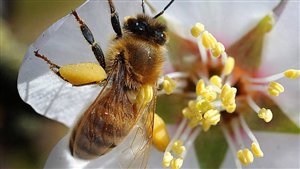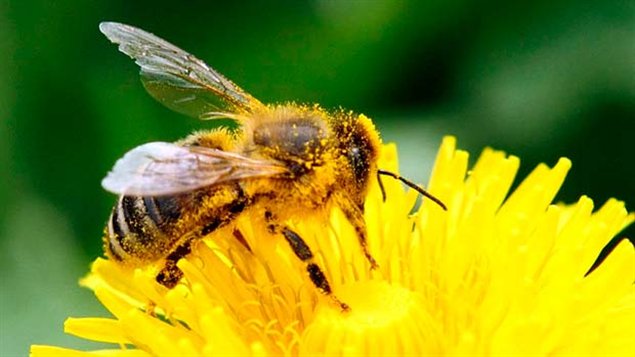A new report by the Canadian Association of Professional Apiculturists (CAPA) shows this has been the worst year ever for losses of bees.

Photo taken in Ontario of a species of “sweat” bee: While figures can be easily gathered for domestic bee losses, there is no way to know how great the losses are among wild bees which poliinate the majority of plants, including crops, around the world. (Sheila Colia)
Bees are vital to the pollination of crops and indeed all sorts of plants, while also generating an important market for honey.
Canada is the world’s 12th largest producer of honey, with annual production valued at around $150 million, while the value of crop pollination is estimated to be nearly $2 billion
Manitoba was the worst hit province with 46 percent rate of loss in honey bee colonies. Ontario was next at 40%, a dramatic increase from 12% of the year before, and New Brunswick also showed a major loss at 37 percent of bees compared to 28 percent in 2010-11
Previously the accepted standard for winter losses in Canada was about 15 percent, but this past year shows nationwide the loss rate has risen to about 29%.
Aside from Manitoba, the other provinces with the highest deaths were Ontario at just under 40 per cent, more than triple the loss figure of the previous year, and New Brunswick at 37 per cent this year, compared to 28 the year before.
Only British Columbia and Nova Scotia experienced a lower loss rate than the year before.
But Canada is not alone in their concerns. The United States, preliminary figures put their honey bee colony death rates at 31 per cent of the population, while Britain saw a slightly higher rate of nearly 34 per cent, the highest loss on record.

All of these figures are for domesticated bees, and do not account for losses of wild bees which are responsible for the majority of plant pollination in the world.
Changing climate, causing changes in flowering times for plants has been raised, and this year in particular a long cold spring was listed as a factor. However parasites, such as the Verroa mite which sucks blood from bees is also weakening colonies.
Pesticides and even fungicides listed as probable links
There is also increasing attention being paid to “fugitive dust” coming from insecticides coating corn seeds.
Earlier this year these “neonicotinoids” were banned for two years in Europe over concerns they were contributing to high rates of bee death.
American researchers have said the pesticide issue is much more complex however.
Earlier this year a research effort was conducted by scientists at the Univeristy of Maryland and the US Department of Agriculturea.

The findings published in the scientific journal PLOS ONE”, showed, no one particular chemical was responsible, but rather, the pollen was contaminated on average with nine different pesticides and fungicides though scientists discovered 21 agricultural chemicals in one sample.
When this pollen collected on the US east coast from hives pollinating cranberry, watermelon and other crops was fed to healthy bees, they showed a significant reduction in their ability to resist infection by a parasite (Nosema ceranae) associated with colony collapse
Widely used fungicides had previously been thought to be harmless to bees as their target is fungus, not insects, and are widely used on crops like apples. However, researchers discovered that bees that ate pollen contaminated with fungicides were three times as likely to be infected by the parasite.







For reasons beyond our control, and for an undetermined period of time, our comment section is now closed. However, our social networks remain open to your contributions.